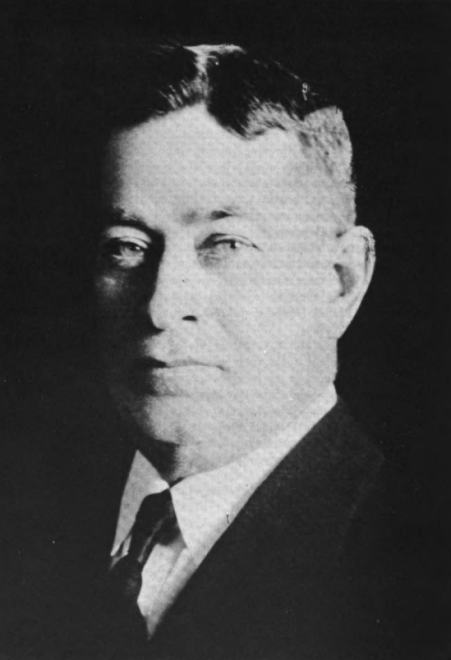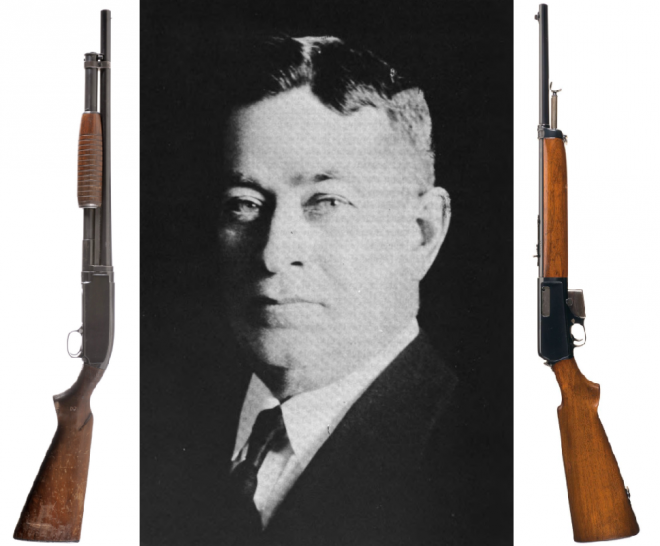The late 1800s and early 1900s are undoubtedly a period of American firearms design dominated by one man, John Moses Browning. But many of Browning’s contemporaries were no less able and men like Andrew Burgess, William Mason, John Pedersen, Frank Burton and T.C. Johnson were all responsible for ingenious and important designs.

A mountain goat hunter poses with his Model 1907 (reddit)
Thomas Crossley Johnson is perhaps one of the lesser known alumni of that generation of gun designers. Johnson was responsible for Winchester’s line of successful semi-automatic rifles, a series of shotgun designs and the Model 54 bolt-action hunting rifle.
Johnson was born in Connecticut in May 1862, the son of Samuel C. Johnson, president of the Yale Safe and Iron Company. Highly educated, he graduated from Yale’s Shefield Scientific School in 1884, he joined the Winchester Repeating Arms company a year later.

T.C. Johnson (Winchester: The Gun That Won the West – H.F. Williamson)
During his fifty years at Winchester, Johnson emerged as a talented inventor, working initially as a draftsman before being assigned to work under William Mason developing new designs. During this time he also worked on improving many of John Browning’s designs, getting them ready for production and drawing up patent specifications to protect them from infringement.

Winchester Deluxe Stocked Model 63 Semi-Automatic Rifle (Rock Island Auctions)
Johnson’s first success came in 1903, with the introduction of the Model 1903 .22 semi-automatic rifle. The 1903 was the first semi-automatic rifle designed and offered commercial sale in North America. The new rifle came at an important time for Winchester in the wake of the break up of the lucrative Winchester-Browning partnership which for almost twenty years had seen Winchester purchase every major design and invention the Browning brothers offered them.
So important was Johnson’s new .22 rifle to Winchester that the company wrote to its dealers and sales agents stating that “any suggestion of their [the Brownings] claiming that they are the ‘whole thing’ and there is nothing left, the .22 Automatic gun is our answer…”

Johnson’s 1901 patent for his semi-automatic .22 (US Patent Office)
Johnson patented his new semi-automatic takedown rifle in April 1901 (US #681,481), the Model 1903 retained the classic Winchester receiver shape reminiscent of the company’s lever action rifles but used a blowback action and fed from a 10-round tube magazine in the butt. By the early 1930s Winchester had built 126,000 Model 1903s. In 1933, Winchester re-introduced the M1903 as the Model 63, chambered in the popular .22LR cartridge. Approximately 175,000 Model 63s were made before production finally ended in the late 1950s.
From 1903 into the late 1920s Johnson was responsible for many of Winchester’s new guns, becoming the company’s chief designer in 1907. The company steadily introduced a series of self loading rifles including the Model 1905, Model 1907, and Model 1910. Johnson filed a patent protecting the design of what would become the Model 1905 in June 1902 (US #720698).

Winchester Model 1905 (RIA)
The Model 1905 has the distinction of being the first centrefire semi-automatic rifle to be sold commercially in the US. It used the same blowback action as the earlier .22 calibre but was chambered in .32 and .35 Winchester Self-Loading. Instead of a tube magazine the 1905 fed from either 5 or 10 round box magazines. Like the 1903, the 1905 lacked a conventional charging handle – instead having an operating sleeve beneath the barrel, projecting from the fore-end.

Johnson’s 1902 patent for what would become Model 1905 (US Patent Office)
In 1907 Winchester released a version of the rifle chambered in the more powerful .351 Winchester Self-loading suitable for hunting medium sized game. It also proved popular with police departments and saw limited military use during World War One with France, Britain, Russia and the US. Both the 1907 and the later 1910 had noticeably thicker fore-ends to prevent cracking.

Winchester Model 1907 (RIA)
The final rifle in Johnson’s blowback self-loading series was the Model 1910, chambered in .401 Winchester Self-Loading, designed to take large game such as deer. Again the 1910 saw some military purchases from France and Russia during the Great War. The 1910 remained in production for nearly 30 years and over 20,000 were manufactured.

Winchester Model 1910 (RIA)
During the early 1900s, Johnson, a prolific designer patented numerous innovations including sights (US #1220637), stock pieces, take-down systems, locking methods, scope mounting systems (US #852119 & #870295), hollow-point projectiles (US #1077607 & #1084342) and an ‘impact illuminating bullet’ (US #1088027).
With the break from Browning still fresh, T.G. Bennett, Winchester’s managing director, asked Johnson to develop a semi-automatic shotgun to rival Browning’s Auto-5/Remington Model 11 – the gun that Winchester had declined to buy from Browning. Designing a gun that avoiding infringing Browning’s patents proved no easy feat. Johnson spent over 5 years developing his shotgun – the Model 1911 (US #768665). The Model 1911 used the same long-recoil principle as Browning’s design but Browning’s patent protected the Auto-5’s cocking handle, so the Model 1911 had to be cocked by grasping the barrel itself and pulling it backwards. This led to a somewhat dangerous and questionable manual of arms where some users placed the gun on the ground and used their weight to pressed down on the barrel, this led to a number of injuries and fatalities during loading and unloading.
Despite Winchesters efforts the Model 1911 was only a moderate success and failed to beat Browning’s design in the marketplace. Not only was the 1911 expensive, at $38, it also had problems with its fibre recoil washers breaking down which meant the shotgun’s recoil could become painfully strong. While the Auto-5 remained in continuous production for almost a century, Winchester discontinued the Model 1911 in 1925.

12 gauge Model 1911 (RIA)
Johnson was responsible for another safer and more successful shotgun, the slide action Model 12, introduced in 1912. The Model 12 had an internal hammer and a six round magazine tube. The Model 12 owed some of its design to Browning’s 1893/97 pump action but improved the earlier weapon’s ergonomics. The Model 12 was adopted by the US military and saw action during both world wars, Korea and Vietnam. Production ended in 1964 when manufacturing costs meant it couldn’t compete, in terms of price, with more modern shotguns.

Winchester Model 1912 (RIA)
From 1914 Johnson turned his attention to developing a bolt action rifle suitable for military adoption. The Model A used a modified Mauser action and had a stock profile similar to the M1903 Springfield. Between 1914 and 1919 the rifle evolved steadily through a series of prototypes.
During the war Winchester manufactured both the British Pattern 1914 and the US Model of 1917, which evolved from it. But according to historian Herbert Houze the Model A was also considered as an option if the P14 proved too difficult to manufacture. The various prototype models of Johnson’s bolt action are currently held by the Cody Firearms Museum, a photo of some of them is available here.

Model 52 target rifle with Winchester scope (RIA)
After the war Johnson and Frank Burton set about designing a new .22 calibre target rifle, the Model 52. The Model 52 proved to be extremely popular with target shooters with over 100,000 made and production continuing into the 1980s. Initially, designed to be similar to the service rifles returning soldiers were familiar with it was also hoped that the military would also purchase it as a training rifle.

Winchester Model 54 (RIA)
In 1925, Winchester introduced the short-lived bolt action Model 54, a development of one of Johnson’s prototype military rifles. The Model 54 was Winchester’s first rifle designed to handle high velocity ammunition and chambered a number of calibres including .30-06 and .270 Winchester. The 54 was discontinued in 1936, but influenced the famous Model 70 which replaced it. Some 50,000 Model 54s were made before production ceased.

Winchester’s first double barrel shotgun – the Model 21 (RIA)
The final Winchester firearm to draw on Johnson’s work was the Model 21, introduced in 1930. It was Winchester’s first traditional double barrel shotgun. While the project was led by Frank Burton, Johnson’s safety mechanism from a patent filed almost twenty years earlier (US #995790) was used. Available with one or two triggers it proved a popular skeet shooting gun with everyone from farmers to film stars with Charlie Chaplin, Gary Cooper and Errol Flynn all owning Model 21s.
Thomas Crossley Johnson lead Winchester’s design department for nearly three decades, he was responsible for bringing many of John Browning’s rough toolroom prototypes to production and guided the company through some of its most difficult times. He was undoubtedly a talented designer and skilled engineer who deserves more recognition than he, and many of his contemporaries, receive today. Johnson died in June 1934, aged 72.
Sources:
Winchester Repeating Arms Company 1865-1981, H.A. Houze, (2004)
The History of Winchester Firearms 1866-1992, T. Henshaw, (1993)
Winchester: The Gun That Won the West, H. F. Williamson. (1952)
 Your Privacy Choices
Your Privacy Choices
